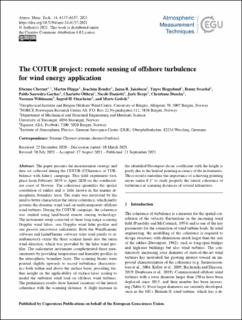| dc.contributor.author | Cheynet, Etienne | |
| dc.contributor.author | Flügge, Martin | |
| dc.contributor.author | Reuder, Joachim | |
| dc.contributor.author | Jakobsen, Jasna Bogunovic | |
| dc.contributor.author | Heggelund, Yngve | |
| dc.contributor.author | Svardal, Benny | |
| dc.contributor.author | Saavedra Garfias, Pablo Andres | |
| dc.contributor.author | Obhrai, Charlotte | |
| dc.contributor.author | Daniotti, Nicolo | |
| dc.contributor.author | Berge, Jarle | |
| dc.contributor.author | Duscha, Christiane Anabell | |
| dc.contributor.author | Wildmann, Norman | |
| dc.contributor.author | Onarheim, Ingrid Husøy | |
| dc.contributor.author | Godvik, Marte | |
| dc.date.accessioned | 2021-10-26T07:48:33Z | |
| dc.date.available | 2021-10-26T07:48:33Z | |
| dc.date.created | 2021-09-23T07:29:51Z | |
| dc.date.issued | 2021-09 | |
| dc.identifier.citation | Cheynet, E., Flügge, M., Reuder, J. et al. (2021) The COTUR project: remote sensing of offshore turbulence for wind energy application. Atmospheric Measurement Techniques, 14, pp. 6137–6157 | en_US |
| dc.identifier.issn | 1867-1381 | |
| dc.identifier.uri | https://hdl.handle.net/11250/2825546 | |
| dc.description.abstract | The paper presents the measurement strategy and data set collected during the COTUR (COherence of TURbulence with lidars) campaign. This field experiment took place from February 2019 to April 2020 on the southwestern coast of Norway. The coherence quantifies the spatial correlation of eddies and is little known in the marine atmospheric boundary layer. The study was motivated by the need to better characterize the lateral coherence, which partly governs the dynamic wind load on multi-megawatt offshore wind turbines. During the COTUR campaign, the coherence was studied using land-based remote sensing technology. The instrument setup consisted of three long-range scanning Doppler wind lidars, one Doppler wind lidar profiler and one passive microwave radiometer. Both the WindScanner software and LidarPlanner software were used jointly to simultaneously orient the three scanner heads into the mean wind direction, which was provided by the lidar wind profiler. The radiometer instrument complemented these measurements by providing temperature and humidity profiles in the atmospheric boundary layer. The scanning beams were pointed slightly upwards to record turbulence characteristics both within and above the surface layer, providing further insight on the applicability of surface-layer scaling to model the turbulent wind load on offshore wind turbines. The preliminary results show limited variations of the lateral coherence with the scanning distance. A slight increase in the identified Davenport decay coefficient with the height is partly due to the limited pointing accuracy of the instruments. These results underline the importance of achieving pointing errors under 0.1∘ to study properly the lateral coherence of turbulence at scanning distances of several kilometres. | en_US |
| dc.language.iso | eng | en_US |
| dc.publisher | Copernicus Publications | en_US |
| dc.rights | Navngivelse 4.0 Internasjonal | * |
| dc.rights.uri | http://creativecommons.org/licenses/by/4.0/deed.no | * |
| dc.subject | energi | en_US |
| dc.subject | offshore vindkraft | en_US |
| dc.subject | vindturbiner | en_US |
| dc.title | The COTUR project: remote sensing of offshore turbulence for wind energy application | en_US |
| dc.type | Peer reviewed | en_US |
| dc.type | Journal article | en_US |
| dc.description.version | publishedVersion | en_US |
| dc.rights.holder | © Author(s) 2021 | en_US |
| dc.subject.nsi | VDP::Teknologi: 500 | en_US |
| dc.source.pagenumber | 6137–6157 | en_US |
| dc.source.volume | 14 | en_US |
| dc.source.journal | Atmospheric Measurement Techniques | en_US |
| dc.identifier.doi | 10.5194/amt-14-6137-2021 | |
| dc.identifier.cristin | 1937385 | |
| cristin.ispublished | true | |
| cristin.fulltext | original | |
| cristin.qualitycode | 1 | |

